
Keeping the floodwaters at bay

As part of a project to protect the Lucerne area and its landmarks, the old town is undergoing a mix of reconstructive surgery and preventive medicine.
Normally the domain of ducks and swans, the River Reuss and its banks are now the temporary home of clunky construction equipment. It’s just the beginning of a SFr23 million ($19.5 million) project designed to keep floodwaters at bay.
In January crews set about repairing and improving the city’s floodgates. Built between 1859 and 1861, the Reuss Dam regulates the level of Lake Lucerne and controls the flow of its water into the River Reuss.
In nearly 150 years of service, the dam has never been maintained comprehensively. The facilities took a severe beating in August 2005, when torrential rains caused serious flooding in central Switzerland. Lake Lucerne overflowed into the city’s streets and buildings, leaving some areas underwater for days.
Unable to cope with the sudden rush of water, one section of the dam was completely destroyed. Other parts are now in a desolate state – leaving Lucerne and the communities downriver in a vulnerable position in the event of another flood.
Balancing act
According to cantonal engineer Fredy Rey, the project has three primary goals: flood defence, environmental protection and monument conservation.
“All three have clear requirements. This project is a compromise between the three issues,” Rey said.
Reducing the threat of flooding and increasing the capacity to deal with the flow of water is essential; the welfare of wildlife and area moorland also needs to be considered.
At the same time, historic structures like the Nadelwehr (Needle Dam) and the Spreuer Bridge must be maintained properly. It’s a delicate balancing act for those involved with the project – quite literally so for those working along the water.
“We have to be extraordinarily precise and careful to ensure that nothing goes wrong. Otherwise, it could be very damaging for buildings in the area,” Rey said.
The project will be carried out in stages so that the current facilities can still do their job. For example, it’s important for Rey and his team to do riverbed work in the winter, when the water levels are at their lowest.
In addition to repairing or replacing the existing equipment, the crew will deepen the riverbed to improve the flow of water. Some 35,000 cubic metres of sand and gravel will be excavated from the riverbed, the equivalent of about 4,000 truckloads. If all goes as planned, the project will be completed in 2011.
Leery locals
For a while it looked as though the project would never get underway.
Despite overwhelming support from within the cantonal parliament in 2007, opponents launched a referendum. They argued that the expensive project would reduce the appeal of the old town.
In June 2008 the cantonal referendum yielded interesting results: although 56 per cent of Lucerne’s city voters were against the Reuss dam project, voters across the canton approved it with a 58 per cent majority.
The cost of the project will be split between Lucerne and the neighbouring cantons of Obwalden, Nidwalden, Schwyz and Uri. The federal government is helping each canton to finance its share.
Tourist distraction?
Some people had worried that the project would mean the loss of the so-called “Needle Dam”, characterised by the long wooden pegs placed in the water.
“From a tourism perspective, it’s important to keep the Needle Dam in place. Guests find it really interesting to see how the water level of Lake Lucerne is regulated,” said Yves Schmoker of the Lucerne Tourist Board.
Rey agreed: “The basic principle is ingenious; it still works after 150 years! It’s a wonderful attraction and a piece of homeland.”
However, safety is a key goal in the dam’s restoration. In order to operate it in its current form, city workers have to cross a narrow catwalk to position the wooden pegs. This can be a risky manoeuvre, especially during wet weather. Rey says new technology will help make it easier and safer to activate the dam.
Downsides
For a city that thrives on tourism, such a major construction project can have its downsides.
“Given the noise, dust and certain restrictions, a construction site is always a disadvantage for a tourist city,” says Schmoker.
As a member of the auxiliary group for the Reuss dam project, Schmoker emphasises the importance of good communication on all sides.
Though the years ahead may be trying for residents and local businesses, the best bet for everyone may simply be to go with the flow.
swissinfo, Susan Vogel-Misicka in Lucerne
August 2005: Flooding causes serious damage in Lucerne and communities downriver.
September 2007: Canton Lucerne’s parliament approves the project by 92 votes to four.
November 2007: Opponents collect enough signatures for a referendum.
June 2008: Although 56% of Lucerne’s city voters are against it, it’s the overall canton results that count: 58% of the canton’s voters approve the project.
January 2009: Construction begins.
2011: Construction scheduled to end.
Lucerne: SFr10,956,000 (48%)
Schwyz: SFr3,652,000 (16%)
Nidwalden: SFr3,423,750 (15%)
Uri: SFr2,967,250 (13%)
Obwalden: SFr1,826,000 (8%)
Total: SFr22,825,000

In compliance with the JTI standards
More: SWI swissinfo.ch certified by the Journalism Trust Initiative







































You can find an overview of ongoing debates with our journalists here . Please join us!
If you want to start a conversation about a topic raised in this article or want to report factual errors, email us at english@swissinfo.ch.